Battle of Tali-Ihantala
| ||||||||||||||||||||||||||||||
The Battle of Tali-Ihantala (June 25 to July 9, 1944) was part of the Finnish-Soviet Continuation War (1941–1944), which occurred during World War II. The battle was fought between Finnish forces—using war materiel provided by Germany—and Soviet forces. To date, it is the largest battle in the history of the Nordic countries.[12]
The battle was one of attrition, with the Finns suffering proportionally more casualties than the Soviet forces.[13] It marked a point in the Soviet offensive when the Finnish forces first prevented the Soviets from making any significant gains.[13][14] However, already earlier at Siiranmäki and Perkjärvi the Finns had halted advancing Soviet forces.[15] Finnish forces achieved a defensive victory,[2][3][16] although Russian historian N. Baryshnikov criticizes this as an exaggeration.[14]
After the Soviets had failed to create any breakthroughs at Tali-Ihantala, Viborg Bay, or Vuosalmi, the Soviet Leningrad Front started the previously planned transfer [14][17][18][19] of troops from the Karelian Isthmus to support Operation Bagration, where they were encountering particularly fierce resistance.[2] Though the Leningrad Front failed to advance into Finland as ordered by the Stavka,[19][20][21][22][23] some historians state that the offensive did eventually force Finland from the war.[24][25][26]
Background


After the initial Finnish advance of 1941, the Continuation War was stabilized to trench warfare with very little activity on either side. When the Siege of Leningrad was lifted in January 1944, the Stavka received orders to plan an offensive against Finland to push it out of the war.
The Soviet attack on the Finnish front commenced on the Karelian Isthmus on June 9, 1944, (coordinated with the Allied Invasion of Normandy). Three Soviet armies were pitted there against the Finns, among them several experienced Guard formations.[5]
The attack soon breached the Finnish front line of defence in Valkeasaari on June 10, and the Finnish forces retreated to their secondary defence line, the VT-line (which ran between Vammelsuu and Taipale). The Soviet attack was supported by a massive artillery barrage, air bombardments, and armoured forces.[5]
The VT-line was breached in Sahakylä and Kuuterselkä on June 14; and after a failed counterattack in Kuuterselkä by the Finnish armoured division, the Finnish defence had to be pulled back to the VKT-line (Viipuri – Kuparsaari – Taipale).[5]
The abandonment of the VT-line was followed by a week of retreat and delaying battles. The Soviet offensive was crowned when the city of Viborg was captured by the Soviets on June 20 after only a short battle. Despite the Red Army’s great success in smashing two Finnish defense lines and capturing a substantial piece of territory in just ten days, it had failed to destroy the Finnish army which was able to concentrate its depleted forces on the VKT-line, and had time to get reinforcements from the other main front north of Lake Ladoga.[5]
Baron Mannerheim, the Finnish commander in chief, had asked for German help on June 12, and on June 16 the Flight Detachment Kuhlmey (a composite ad hoc wing of about 70 dive bombers and ground attack fighters, with a fighter and an air transport component) arrived in Finland. A few days later the battalion-sized 303 Assault Gun Brigade and the 122nd Division Greif also arrived; but after that the Germans offered only supplies, the most important of which were Panzerfaust anti-tank weapons.[5]
On June 21 the Stavka ordered the Leningrad Front to breach the defensive line and advance to Lake Saimaa.[17]
On June 21 the Finnish government asked the Soviets about the possibility for peace and accompanying Soviet conditions. The Soviet response arrived on June 23; it demanded a signed statement to the effect that Finland was ready to surrender and was asking for peace," but the Finnish government rejected this.
German Foreign Minister Ribbentrop arrived on June 22 and demanded a guarantee that Finland would fight to the end as a precondition of continued German military support. President Ryti gave this guarantee as a personal undertaking.
Order of battle
Finnish
HQ of the Commander of the Isthmus Forces (Lt. Gen. Karl Lennart Oesch)
- Finnish IV AK (Lt. Gen. Taavetti Laatikainen)
- 3rd Brigade "Blue Brigade" (Col. Lauri Haanterä)
- Finnish 3rd Division (Mj. Gen. Aaro Pajari)
- Finnish 4th Division (Mj. Gen. Pietari Autti)
- Finnish 18th Division (Mj. Gen. Paavo Paalu sacked June 26, Col. Otto Snellman),
- since June 27 11th Division (Mj. Gen. Kaarlo Heiskanen).
- Finnish 6th Division (Mj. Gen. Einar Vihma)
- Finnish Armoured Division (MJ. Gen. Ruben Lagus)
- LeR 3 (Lt. Col E. Magnusson) (33 Messerschmitt Bf 109, 18 Brewster Buffalo 239 Fighters and 1 Fokker C.X reconnaissance)
- LeR 4 (Col. O. Sarko) (33 Bristol Blenheim, 12 Junkers Ju 88, 8 Dornier Do 17Z bombers)
German
- German air unit Gefechtsverband Kuhlmey (Lt. Col. Kurt Kuhlmey) arrived in Finland on June 16. (23–43 Fw-190 A-6/F-8 fighters and ground attack aircraft, 24–30 Ju-87 D Stukas and 1–8 Bf-109 G-8 reconnaissance fighters)
- German Sturmgeschütz-Brigade 303 (Cpt. Hans-Wilhelm Cardeneo) arrived in Finland on June 22. (22 StuG III Ausf. G assault guns, 9 StuH 42 assault howitzers)
Soviet
The Soviet forces that took part in the battle belonged to the Soviet Leningrad Front under Marshall Leonid Govorov's command. In the Tali-Ihantala region, the Soviet 21st Army (Gusev) attacked; the 30th Guards Rifle Corps, 97th, 108th, 109th, and 110th Rifle Corps took part in the battle. These five corps had together the 45th, 63rd and 64th Guards Rifle Divisions and 46th, 72nd, 90th, 109th, 168th, 178th, 265th, 268th, 286th, 314th, 358th and 372nd Rifle Divisions. The 21st Army did not commit all of its forces simultaneously but instead kept some of the forces in reserve and committed them only after the initially committed formations had spent their offensive capability and required rest and refit. Also, at the beginning of the battle, some of the Soviet forces that later took part in the battle were deployed on nearby sections of the front, such as the 108th Rifle Corps with its three divisions being deployed to Viborg and the Viborg Bay area. Soviet 23rd Army (Tserepanov) attacked on the front immediately east of the 21st Army towards Noskua. It deployed the Soviet 6th Corps which consisted of the 13th, 177th, and 382nd Rifle Divisions.
The terrain
The Battle of Tali-Ihantala was fought in a small area (100 km²) between the northern tip of Viborg Bay and the River Vuoksi around the villages of Tali and Ihantala, 8–14 km north-east from Viborg.
The Soviet forces were concentrated on the area east of the city of Viborg, from where the attack started, through the southern village of Tali, northwards to Ihantala (Petrovka). This was the only suitable exit terrain for armoured forces out of the Karelian Isthmus, 10 km wide, broken by small lakes and limited by Saimaa Canal on the west and the River Vuoksi on the east.
Tali: June 25 – June 30
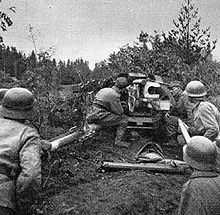
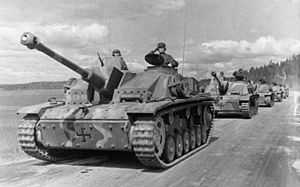
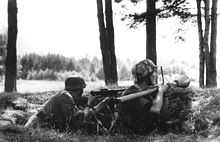
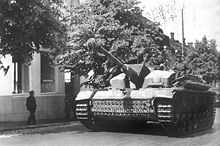
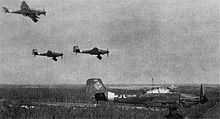
The fighting in the area began on June 20.
June 20 – June 24
The first days were a defensive battle that the Finnish 18th Division (6th and 48th Infantry Regiment and 28th Independent Battalion) and 3rd Brigade (4 battalions) and the 3rd battalion of the 13th Regiment (Swedish speaking) fought against the Soviet 97th and 109th Corps and 152nd Tank Brigade. The defenders were hit especially hard by artillery and air attacks, but managed to put up a strong defense that stalled the Soviet advance long enough for Finnish reinforcements to join the battle.[5]
June 25 – June 26
The action of June 25 started at 0630 with a Soviet one-hour heavy artillery bombardment and air attack, followed by a major Soviet offensive from Tali village at 0730. The Soviets' goal in the attack was to reach Imatra-Lappeenranta-Suurpäälä before June 28. The 30th Guards Rifle Corps had now also joined the battle.
The Soviet army tried to break through along both sides of Lake Leitimojärvi. The attack on the eastern side of the lake was stopped after three kilometers by the Finnish 4th Division. On the west side, the Soviet infantry of the 45th Guards Division and the 109th Corps got stuck in defensive positions around the hills of Konkkalanvuoret defended by the Finnish regiment JR48. However, Soviet tanks from the 27th Tank Regiment were able to force their way to the Portinhoikka crossroads.
The Soviets also attacked with the 178th Division over the Saarela Strait, which was defended by Finnish regiment JR6's 1st battalion, but the attack was thrown back here as well. Meanwhile, the Soviet 97th Corps attacked the Finnish 3rd Brigade’s positions but gained little ground. At this stage the situation was very critical for the Finns, whose units were at risk of being cut off and surrounded. This would inevitably have led to the defeat of the Finnish IV Corps and the loss of the VKT line.
The Finns were able to organize a counterattack with the reserves of the 18th Division, parts of the 17th Division, and some battle groups from the 4th Division. Later that afternoon, the Finnish armored division joined the battle and managed to push the Soviet attackers on the west side of the Lake Leitimojärvi back to their starting point. The Soviet 27th Tank Regiment was annihilated except for six tanks that were captured by the Finns.
June 27 – June 30
More Finnish units joined the battle along with the German 303rd Sturmgeschütz brigade. The Finnish units had been spread out and mixed in the battle, which made the organization of a concentrated defence difficult. The Finnish units were therefore reorganized into two battle groups, BG Björkman and BG Puroma. The Soviets also reinforced their forces with the 108th Corps. At this stage, the Soviet forces included at least one armored brigade, two armored breakthrough regiments, and four assault gun regiments.
The Finns tried to regain the initiative by attacking the four Soviet divisions (46th Guard, 63rd Guard, 64th Guard, 268th Division and the 30th Guards Tank Brigade) - that had broken through east of Leitimojärvi – from three directions, in order to make a "motti" of the Soviet divisions. The two battle groups, Björkman and Puroma, did manage to advance to within one kilometer of each other but failed to surround the Soviet divisions who had set themselves up into a hedgehog defense around Talinmylly.
The Finnish attack failed because of heavy Soviet resistance especially with massed tanks and artillery, and because communication between several Finnish battalions broke down during the attack. Colonel Puroma said after the war that the one thing he regretted was the failure to make a motti out of Talinmylly. The attack gave the Finnish defenders 72 hours of respite at the same time as the fresh Finnish 6th and 11th Divisions reached the battlefield. Several tank battles took place during this fighting.
On June 28, air activity was high on both sides as Finnish bombers and German Stukas pounded the Soviet formations. The Soviet Air Force also attacked from the air and hit the staff of the Finnish Armored Division hard with bombers from the Soviet 276th Bomber Division. On June 28, the Finnish commander Oesch gave the order for Finnish units to withdraw back to the line of Vakkila-Ihantalajärvi-Kokkoselkä-Noskuanselkä (still within the VKT line), but they became caught up in a new Soviet offensive.
June 29 was the hardest and worst day for the Finns during the whole battle, and defeat was not far off. The Finnish forces finally managed to restore the line on June 29 after very bloody fighting. On June 30, the Finnish forces retreated from Tali. The heaviest fighting took place between July 1 and July 2 when the Finns lost some 800 men per day.[5]
Ihantala: July 1 – July 9
The ensuing Finnish concentration of artillery fire was the heaviest in the country's military history.[27] It was based on the famed fire correction method of Finnish Artillery General Vilho Petter Nenonen, which enabled easy fire correction and quick changes of targets.[5] At the critical Ihantala sector of the battle, the Finnish defenders managed to concentrate their fire to the extent of smashing the advancing Soviet spearhead.[27] The clever fire control system enabled as many as 21 batteries, totaling some 250 guns, to fire at the same target simultaneously in the battle; the fire controller did not need to be aware of the location of individual batteries to guide their fire, which made quick fire concentration and target switching possible. This concentration was considered a world record at the time.[5]
According to Bitva za Leningrad 1941–1944 ("The Battle of Leningrad") edited by Lieutenant General S.P. Platonov:[28]
"The repeated offensive attempts by the Soviet Forces failed ... to gain results. The enemy succeeded in significantly tightening its ranks in this area and repuls[ing] all attacks of our troops ... During the offensive operations lasting over three weeks, from June 21 to mid-July, the forces of the right flank of the Leningrad front failed to carry out the tasks assigned to them on the orders of the Supreme Command issued on June 21."
By this time the Finnish army had concentrated half its artillery in the area, along with the army's only armoured division, with StuG III assault guns as its primary weapon, and the German 303 Sturmgeschütz Brigade. The defenders now finally had the new German anti-tank weapons that were previously kept in storage.
On July 2 the Finns intercepted a radio message that the Soviet 63rd Division and 30th Armored Brigade were about to launch an attack on July 3 at 0400 hours. The following morning, two minutes before the supposed attack, 40 Finnish and 40 German bombers bombed the Soviet troops, and 250 guns fired a total of 4,000 artillery shells into the area of the Soviets. On the same day, beginning at 06:00, 200 Soviet planes and their infantry attacked the Finnish troops. By 19:00 the Finnish troops had restored their lines.[5]
On July 6 the Soviet forces had some success, despite the Finnish 6th Division having 18 artillery battalions and one heavy battery for their defence. However, the Soviets were thrown back the following day, and their counterattacks at 13:30 and 19:00 that day did not amount to anything. By July 7, the focus of the Soviet attacks was already moving to the area of Vuoksi, and the Soviets now began transferring their best troops to the Narva front in Estonia, to fight the Germans and the Estonians. From July 9, the Soviet troops no longer attempted a break-through. Nevertheless, some fighting continued.[5] Soviet forces were ordered to cease offensive operations and take up defensive positions on July 10 as the Stavka redeployed forces to the Baltic fronts, where the Red Army was encountering "fierce German and Baltic resistance."[29]
Losses
Finnish sources estimate that the Soviet army lost about 300 tanks in the Battle of Tali-Ihantala,[5] mainly to air attacks and close defence weapons. Between 120 and 280 Soviet aircraft were shot down.[5]
The Finnish army reported that 8,561 men were wounded, missing, and/or killed in action. According to Finnish historian Ohto Manninen, the Soviets reported their losses as about 18,000–22,000 killed or wounded, based on the daily and 10-day summary casualty reports of the Soviet 21st Army. The uncertainty about casualties rises from the fact that 25 percent of the forces of the 21st Army didn't participate in the battle.[10] In addition to the losses of the Soviet 21st Army, the Soviet 6th Corps of the 23rd Army that attacked east of the 21st Army closer to Vuoksi waterway suffered 7905 casualties, of which 1458 were killed in action (KIA) and 288 missing in action (MIA), without taking the losses of its supporting formations into account.[11]
Impact
The cease-fire between the Soviet Union and Finland began at 07:00, September 4, 1944, although for the following 24 hours the Red Army failed to comply with it.[30][31]
According to historians Jowett & Snodgrass, Mcateer, Lunde, and Alanen & Moisala, the Battle of Tali-Ihantala, along with other Finnish victories (Battle of Viborg Bay, Battle of Vuosalmi, Battle of Nietjärvi, and Battle of Ilomantsi) achieved during the period, finally convinced the Soviet leadership that conquering Finland was proving difficult, and not worth the cost;[1][2][16][32] the battle was possibly the single most important battle fought in the Continuation War, as it largely determined the final outcome of the war, allowing Finland to conclude the war with relatively favorable terms[16][30] and continue its existence as an autonomous, democratic, and independent nation.[16][33] Finnish researchers state that Soviet sources, such as POW interviews, prove that the Soviets intended to advance all the way to Helsinki.[34] There also existed an order from Stavka to advance far beyond the borders of 1940.[17]
According to Lunde, one of the reasons leading to the Soviet failure was the Finns were able to intercept the Soviet radio messages and to forewarn and prompt the Finnish Army to put up a firmly resolved defense.[12] Also, the existence of the Finnish Salpa Defence Line was an important factor in the peace negotiations in autumn 1944.[35]
Russian historian Nikolai Baryshnikov argues that such views exaggerate the significance and misrepresent the outcome of the Finnish defensive battles of 1944, including the Battle of Tali-Ihantala. According to him, conquering Finland was not one of the known goals of the Soviet offensive,[14][24][25] and there is no solid documentary evidence, such as military orders, that the Soviet high command intended to advance to Helsinki and occupy the country,[36] but the Soviets did intend to advance beyond the borders of 1940.[17] According to Marshall Vasilevsky, already on June 17 it was decided that after the Soviets took Viborg and the Viborg Bay islands, the offensive would stop at the line Elisenvaara-Imatra-Virojoki, Soviet forces would switch to defense, and the main forces of the Leningrad Front would be concentrated on fighting the German forces in Estonia.[14][18] On June 21 a Stavka order was issued for the Leningrad Front to advance to the line mentioned by Vasilevsky. However, it also instructed to then advance further to the line Kouvola-Kotka-Kymi River.[17] There were no orders to advance further to Helsinki.[36] It is also known that Stalin reminded Marshall Govorov that the goal was Berlin, not Helsinki.[36] According to General Shtemenko, the goal was to create a threat to Helsinki and other major political and economic centers in Finland, not conquer the country.[14] According to Baryshnikov, after transferring most of their available forces to the Karelian Isthmus and receiving significant aid from Germany, the Finns managed to slow down and stop the Soviet offensive on the Isthmus before it reached the Finnish border.[14] This boosted the morale of the Finnish troops, who were previously constantly retreating.[14] According to Baryshnikov, Finnish propaganda soon started talking about a victory, and after the war this claim of achieving a victory in stopping the Soviets from conquering Finland became an official theme in Finnish historiography.[14] Many non-Finnish historians have accepted the Finnish view, of a Finnish victory.[2][12][19]
According to Österberg, Stenius, and Östling, the battle of Tali-Ihantala is portrayed in Finland as a Finnish national struggle for survival and "the great defensive victory." This portrayal, these authors allege, is part of a nationalistic view of Finland in World War II, for which the international context is ignored, the role of Finland is exaggerated, and the idea of a separate war is claimed. These authors further contend that substantial German aid is not mentioned or is only hinted at.[37]
Related operations
On June 22, Soviet forces began a wide-front push into Eastern Poland and Belorussia.
At the same time, the Soviet 59th Army attacked the islands in Viborg Bay from July 4 on, and after several days of fighting forced the vastly outnumbered Finnish forces out from most of the islands[14][38] while suffering heavy losses.[38][39] However, the Soviet attack aimed at crossing Viborg Bay was a failure as the Soviet troops were thrown back by the German 122nd Division of the V AK.[38][40]
The Soviet 23rd Army attempted to start the crossing of the River Vuoksi on July 4 at Vuosalmi, but due to the Finnish defense at Äyräpää Ridge, it was unable to start the crossing before July 9.[41][42] Even with the crossing completed, the Soviet forces consisting of elements from three Soviet divisions were not able to expand the beachhead against the defending Finnish 2nd Division, which was later reinforced.[5][41][42] The unsuccessful Soviet breakthrough attempts continued there until July 21.[41]
In addition to Tali-Ihantala, the Finnish front line held fast at Kivisilta and Tienhaara to the north of Viborg Bay.[43][44] There was further heavy fighting on the northeast side of Lake Ladoga, and in the Battle of Ilomantsi the Finns were able to encircle two Soviet divisions, though most of the troops were able to escape.[45][46]
On July 12, Soviet troops received an order to stop their attempts to advance and to dig in. Soon, Finnish scouts noticed trains with empty trucks advancing towards Viborg to take troops away from the Finnish front. They were needed for the great push towards Berlin.[12]
The Finnish government declined further negotiations in late June and did not ask for peace until the Soviet offensive had been stopped. The Finnish government instead used the Ryti-Ribbentropp agreement to strengthen Finnish forces.[26] Only after the Soviet offensive had been stopped on all primary fronts, was President Ryti ready to resign on July 28. He, together with leading social-democrat Väinö Tanner, requested that Commander-in-Chief Mannerheim accept the candidacy for president, thus freeing Finland from the Ryti-Ribbentropp agreement, which had only been made as a personal pledge of President Ryti. Finland then could ask the Soviet Union for peace.[25][26]
See also
- Tali-Ihantala 1944 (film)
References
- ↑ 1.0 1.1 Jowett & Snodgrass (2006). p. 14.
- ↑ 2.0 2.1 2.2 2.3 2.4 Macteer (2009) p. 184
- ↑ 3.0 3.1 Jaques (2007) p. 467
- ↑ Jowett & Snodgrass (2006). "Finnish forces total about 50,000 men of IV Corps (LtGen Taavetti Laatikainen), with 50 per cent of the nation's entire complement of artillery committed to the battle. The main Finnish assets committed at Tali-Ihantala are the 3rd, 4th, 6th & 18th Divs, the 'Lagus' Armd Div, and the 3rd 'Blue' brigade. The Finnish artillery perform magnificently, and their accurate fire is one of the main factors in the victory." p. 14.
- ↑ 5.0 5.1 5.2 5.3 5.4 5.5 5.6 5.7 5.8 5.9 5.10 5.11 5.12 5.13 5.14 5.15 5.16 5.17 Koskimaa, Matti, Veitsenterällä, 1993, ISBN 951-0-18811-5, WSOY
- ↑ Jowett & Snodgrass (2006). "The main Soviet attacking force is the 21st Army, with a total of 150,000 men in 14 infantry divisions, with tank brigades, artillery, and other heavy support assets." p. 13.
- ↑ Kantakoski, Pekka (1998). Punaiset panssarit – Puna-armeijan panssarijoukot 1918–1945 (Red tanks – the Red Army's armoured forces 1918–1945) (in Finnish). Hämeenlinna : Ilves-Paino. p. 512. ISBN 951-98057-0-2.
- ↑ Shigin (2004), pp. 270–271, 316
- ↑ Archives of Soviet Ministry of Defence, daily casualty reports of 21. Army June 29 – July 10, 1944, 10-day casualty summaries of 21. Army, June–July 1944. Daily reports consists 3,198 KIA, 363 MIA and 13,125 WIA. With the information of 10-day summaries, the casualties of the first four days of the battle could be estimated, which gives total Soviet losses to about 22,000 from which 4,500–5,500 KIA/MIA. According to Soviet military medication statistics from the wounded, about 6% died to their wounds, and those would not be included in the numbers above.
- ↑ 10.0 10.1 Manninen, Ohto, Molotovin cocktail, Hitlerin sateenvarjo, 1994, ISBN 951-37-1495-0, Painatuskeskus
- ↑ 11.0 11.1 Raunio, Ari; Kilin, Juri (2008). Jatkosodan puolustustaisteluja 1942–44. Keuruu: Otavan Kirjapaino Oy. p. 192. ISBN 978-951-593-070-5.
- ↑ 12.0 12.1 12.2 12.3 Lunde (2011) p. 306
- ↑ 13.0 13.1 Jowett, P., Snodgrass, B. Finland at War 1939–45 Osprey Publishing. 2006.
- ↑ 14.0 14.1 14.2 14.3 14.4 14.5 14.6 14.7 14.8 14.9 Baryshnikov (2006)
- ↑ Lunde (2011) pp. 286–287
- ↑ 16.0 16.1 16.2 16.3 Lunde (2011) p. 379
- ↑ 17.0 17.1 17.2 17.3 17.4 Zolotarev (1999), pp. 97–98, 368
- ↑ 18.0 18.1 Vasilevsky, Aleksandr (1978). Дело моей жизни [The Point of My Life] (in Russian). Moscow: Politizdat. p. 412.
- ↑ 19.0 19.1 19.2 Moisala & Alanen (1988) pp. 152–154
- ↑ Lehmus K. Tuntematon Mannerheim. Hels., 1967, pp. 179–180
- ↑ Wirtanen A. Salaiset keskustelut Lahti, 1967, p. 268
- ↑ Wirtanen A. Poliitiset muistdmat Hels., 1972, p. 27
- ↑ Seppälä H. Taistelu Leningradista ja Suomi, pp. 272–273
- ↑ 24.0 24.1 Glantz (1998), pp. 201–203
- ↑ 25.0 25.1 25.2 Erickson (1993), pp. 329–330
- ↑ 26.0 26.1 26.2 Lunde (2011) pp. 303–304, 309, 314
- ↑ 27.0 27.1 Maanpuolustuskorkeakoulun historian laitos, Jatkosodan historia 1–6, 1994
- ↑ Platonov, S.P. (editor) (1964). Битва за Ленинград ("The Battle of Leningrad"). Voenizdat Ministerstva oborony SSSR.
- ↑ Jowett & Snodgrass (2006). p. 15.
- ↑ 30.0 30.1 Jakobson, Max, Säkerhetspolitik och historia, 2007, ISBN 978-91-7224-061-2, Hjalmarson & Högbergs Bokförlag AB, Essay pp. 164–177 Avvärjningsegern, defensive victory
- ↑ Part 12 End of Hostilities for the Continuation War
- ↑ Moisala & Alanen (1988) pp. 154–155, 258–261
- ↑ Moisala & Alanen (1988) p. 260
- ↑ Moisala & Alanen (1988) pp. 85, 152–154
- ↑ http://www.battlevault.com/Events/Wolfkrieg-09/WK-09%20Player%20List_files/German/Rob_Prince_Hist.pdf
- ↑ 36.0 36.1 36.2 Baryshnikov (2001)
- ↑ Österberg, Mirja; Stenius, Henrik; Östling, Johan (2011). Nordic Narratives of the Second World War: National Historiographies Revisited. Lund: Nordic Academic Press. pp. 69–70. ISBN 978-91-85509-49-2.
- ↑ 38.0 38.1 38.2 Lunde (2011) p. 307
- ↑ Raunio, Ari; Kilin, Juri (2008). Jatkosodan puolustustaisteluja 1942–44. Keuruu: Otavan Kirjapaino Oy. pp. 204–205. ISBN 978-951-593-070-5.
- ↑ Moisala & Alanen (1988) pp. 143–147
- ↑ 41.0 41.1 41.2 Lunde (2011) pp. 308–309
- ↑ 42.0 42.1 Moisala & Alanen (1988) pp. 147–152
- ↑ Lunde (2011) p. 289
- ↑ Moisala & Alanen (1988) p. 134
- ↑ Lunde (2011) p. 299
- ↑ Moisala & Alanen (1988) pp. 127–129
Bibliography
- Baryshnikov, Nikolai I. (2006). Феномен фальши: 'Победа в противостоянии' [The Phenomenon of Lies: 'The Victory in the Confrontation']. St. Petersburg and the Countries of Northern Europe (in Russian). St. Petersburg: Russian Christian Humanitarian Academy. Retrieved September 15, 2011.
- Baryshnikov, Nikolai I. (2002). Блокада Ленинграда и Финляндия 1941–1944 [Finland and the Siege of Leningrad, 1941–1944] (in Russian). St. Petersburg: Johan Beckman Institute. ISBN 952-5412-10-5.
- Erickson, John (1993). The Road to Berlin: Stalin's War with Germany. New Haven: Yale University Press. ISBN 0-300-07813-7.
- Glantz, David; House, Jonathan (1998). When Titans Clashed: How the Red Army Stopped Hitler. Lawrence: Kansas University Press. ISBN 978-0-7006-0899-7.
- Jaques, Tony (2007). Dictionary of Battles and Sieges: F–O. Westport: Greenwood Press. ISBN 978-0-313-33538-9.
- Jowett, Philip; Snodgrass, Brent (2006). Finland at War 1939–45. Botley: Osprey Publishing. ISBN 978-1-84176-969-1.
- Lunde, Henrik, O. (March 19, 2011). Finland's War of Choice. Casemate Pub. ISBN 978-1-935149-48-4.
- Mcateer, Sean (2009). 500 Days: The War in Eastern Europe, 1944–1945. Dorrance Publishing. ISBN 978-1-4349-6159-4.
- Moisala, U.E.; Alanen, Pertti (1988). Kun hyökkääjän tie pysäytettiin (When the attacker was stopped) (in Finnish). Keuruu: Otava. ISBN 951-1-10386-5.
- Shigin, Grigoriy (2004). Битва за Ленинград: крупные операции, белые пятна, потери [Battle for Leningrad: Large-scale Operations, White Spots, Casualties] (in Russian). St. Petersburg: Poligon. ISBN 5-89173-261-0.
- Zolotarev, V. A., ed. (1999). Русский архив: Великая Отечественная. Ставка ВКГ: Документы и материалы 1944–1945. [Russian Archive. The Great Patriotic War. STAVKA. Documents and Materials 1944–45] (in Russian). Moscow: Terra. ISBN 5-300-01162-2.
